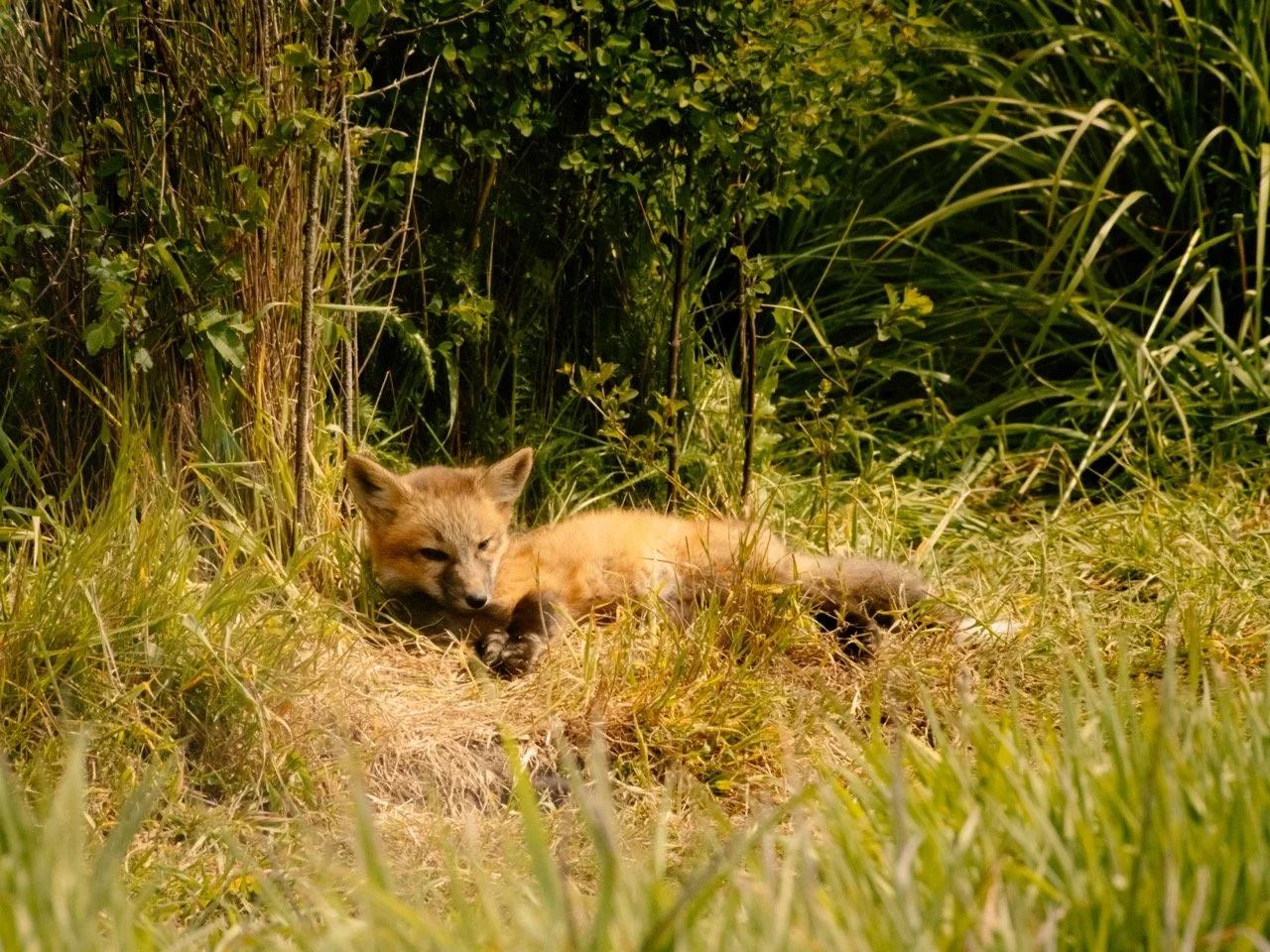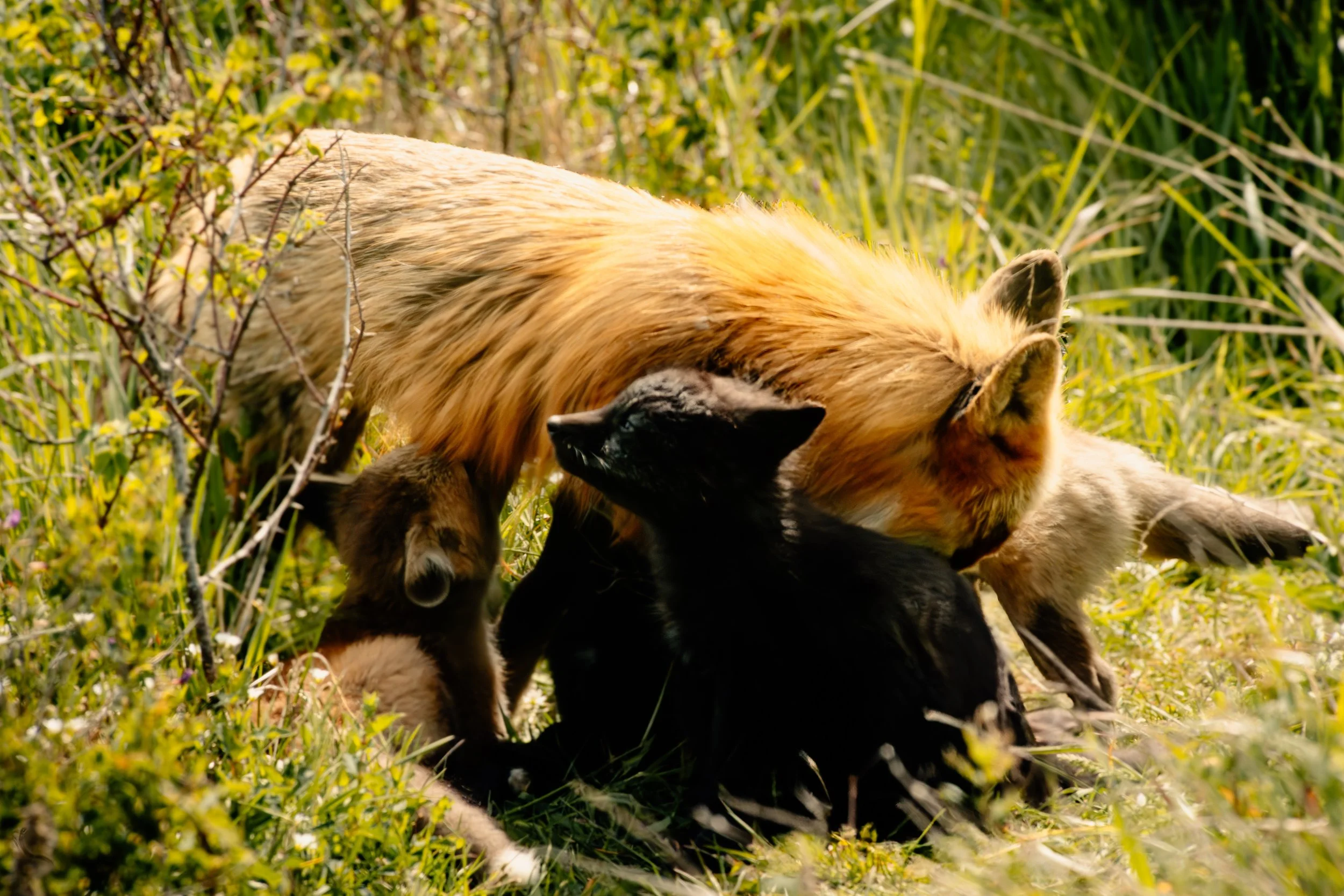Caution For The Cascade Red Fox
As their population dwindles, scientists search for the culprit
Gray colored fox peaking out over the prairie grass.
Story by Jeremy Kent // Photos by Avery Robertson
July 7, 2025
Editor’s Note: Planet photographers were unable to capture pictures of Cascade Red Foxes described in this story due to their scarcity. The accompanying photos depict a non-native Red Fox population introduced by colonizers.
The pale light of early dawn is only just beginning to light up the cold alpine sky. For a human, this is the prime time to sleep in, but for Snag, this is prime hunting time. His honed senses pick up slight movement: a snowshoe hare. He creeps up, moving through the snow like a ghost with the help of his well-adapted paws. A thick fur coat keeps him warm, and his lightweight frame helps him to stay above the thick snow.
He’s close now, well within pouncing range. His prey has not sensed his presence, and he seizes his chance. It’s a successful hunt. He tastes warm blood as he stalks off into the shelter of the stunted alpine forests. This meal will allow him another day, and in turn, provide his dwindling species another day too.
Snag is a Cascade red fox, an alpine species native to the Cascade Mountains. Many generations ago, their range extended from British Columbia down to the southernmost foothills of the mountains, just north of the Columbia River.
Now, very few remain.
Mother fox watching intently while feeding her kits.
If one counted up all of the remaining individuals—Snag included—there may be a few hundred left in the world. Enigmatic and reclusive, very little is known about this endangered species.
The Cascade Red Foxes Report says that there are 51 foxes left in the wild. However, Jocelyn Akins, founder of the Carnivore Project, says her research points to upwards of 200 individuals left.
Cascade red foxes are an important keystone species for the alpine environment. The loss of this species could have negative impacts on the ecosystem, though their replacement by other predators — including the non-native lowland red fox — could offset this imbalance. Unfortunately, further studies must be conducted to confirm these theories.
The Cascade red fox migrated from Asia into North America 300,000 years ago, crossing the Bering land bridge. From there, their ancestors spread across the mountains of the west coast and the intermountain west, forming into isolated populations of alpine foxes.
Studies from the Washington Department of Fish and Wildlife haven’t established that climate change is the most important factor for the decline in the Cascade red fox population. Still, rising temperatures in the Pacific Northwest’s alpine climates have caused reduced snowpack, altered fire regimes and increased outbreaks of diseases and parasites. Warming from climate change has forced forest cover to move up in elevation across the Cascades, shrinking the mountain prairies this species relies on.
Natalie Furness, a geographic information system specialist at Western Washington University, conducted a mapping project on the Cascade red fox shifting habitat. The results showed how changing tree cover may disrupt hunting patterns.
“[Cascade red foxes] really like those subalpine meadows, but they need space to see and run,” Furness explained.
Despite this, Gregory Green, a senior instructor at Western Washington University, says that Cascade red foxes are resilient, and their prey is too.
“Whether we’re seeing [the effects of climate change] or not depends on the particular species,” Green said. “[Cascade red foxes] are a mouser for the most part ... they’re taking a lot of animals that are still going to be [in] relatively high numbers. Hoary marmots are likely increasing because of warming.”
With uncertainty around the effect of climate change on the population, researchers say we must look to human activity to explain the drastic population decline. Studies have shown that while climate change may not have affected these alpine foxes, the fur trade and predator eradication policies of the early 20th century devastated the local population.
Fox kit ready to take a nap in the warm sun.
Despite their name, the Cascade red fox sometimes appears more silver in coloration, a hue that trappers found enticing.
“The silver fur was worth a lot of money,” Green said. “The prices went up, so there was a lot of pressure to trap them.”
To protect this unique alpine species, the Washington Department of Fish and Wildlife has listed the Cascade red fox as endangered since 2022. This protection prohibits the trapping or killing of the species.
Organizations like the Cascade Carnivore Project have worked to conduct long-term studies to monitor the Cascade red fox’s populations and locations to gain a better understanding of the species’ current standing.
Their goals are to figure out what their diet consists of, where they are denning and hunting and how the environment impacts their behaviors. Further outreach and education programs have worked to educate the community and to help change human habits to better protect them.
“Fox habituation is related to human disturbance such as ski areas and roads, and results in some mortality from vehicle collisions,” Akins said. “But many [foxes] ranges are far away from human habitation, and these individuals, and the population as a whole, is likely threatened by larger drivers such as climate change.”
Adult fox feeding her kits in the sun.
While state regulators have tried to protect the last of the Cascade red foxes, the results have been mixed. For instance, the Carnivore Project’s education and outreach programs are making strides to save the species.
Long-term monitoring programs have also helped biologists and ecologists to track the current population with a modicum of certainty and track where the last suitable alpine habitat is for these creatures.
On the flip side, the project's failures are that human intervention is expected to hinder the Cascade red fox, and so wildlife experts believe the best course of action is to take a hands-off approach and hope for the best.
“Some species it’s a habitat issue, some species it’s a harvest issue, and for the carnivores it’s been a harvest issue,” Green said.
Despite the best efforts of state regulators, habitats are still disappearing, threatening the remaining population. Attempts to pin down the exact remaining alpine habitat and the true numbers of the Cascade red fox have failed. Even now, ecologists don’t know enough about these elusive alpine foxes.
“Globally, the red fox has always been a common species,” Akins explained. “Many wildlife managers didn’t realize that there was a special species of fox that lived in the mountains . . . and because they were out of sight, they were out of mind.”




